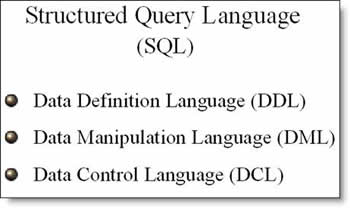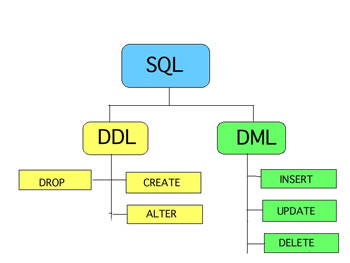Difference between DDL and DML in Tabular Form
Key Difference: DDL, which stands for Data Definition Language, is mainly used to define the schema within a database. It also defines the relationship between the entries within the database. DML, which stands for Data Manipulation Language, is also a Database Language. Nevertheless, unlike DDL, DML can be utilized to insert, delete, revive, and modify the data, rather than just specify it.
 DDL and DML are two types of Database Languages. They are called sub-languages, as they have fewer facilities than full-fledged programming languages. Both belong to a family of syntax elements that are primarily used in reference to databases. Both utilize statements and commands of Structured Query Language (SQL), which are used to retrieve and manipulate data in a relational database.
DDL and DML are two types of Database Languages. They are called sub-languages, as they have fewer facilities than full-fledged programming languages. Both belong to a family of syntax elements that are primarily used in reference to databases. Both utilize statements and commands of Structured Query Language (SQL), which are used to retrieve and manipulate data in a relational database.
DDL, which stands for Data Definition Language, is mainly used to define the schema within a database. It also defines the relationship between the entries within the database. DDL can also be used to define certain security constraints. As previously stated DDL primarily utilizes SQL commands which are used to create, alter, and destroy database objects.
Once executed, the DDL commands results in new tables which are stored in "system catalog". This catalog is also called a data dictionary or data directory. However, the changes can only define the data within the directory and their relationship to one another. Whereas, DML can be used to modify the data itself.
DML, which stands for Data Manipulation Language, is also a Database Language. Like DDL, it’s primarily role is within database management. Nevertheless, unlike DDL, DML can be utilized to insert, delete, revive, and modify the data, rather than just specify it.
 These data manipulations can be applied at internal, conceptual and external levels of schemas. However, it should be noted that the level of complexity at each schema level varies from one another. For example, complex low-level procedures allow efficient access, but procedures focus on ease of usage, thus they involve low complexity.
These data manipulations can be applied at internal, conceptual and external levels of schemas. However, it should be noted that the level of complexity at each schema level varies from one another. For example, complex low-level procedures allow efficient access, but procedures focus on ease of usage, thus they involve low complexity.
DML is also often used in retrieval of data. It can be divided into two segments as based on its retrieval constructs: Procedural DML, and Non-procedural DML. Procedural DML specifies what data needs to be retrieved and how the required data should be retrieved. Non-procedural DML specifies what data needs to be retrieved but not how the required data should be retrieved.
Comparison between DDL and DML in Tabular Form:
|
|
DDL |
DML |
|
Full Form |
Data Definition Language |
Data Manipulation Language |
|
Type of |
Database Language |
Database Language |
|
Subset of |
Structured Query Language (SQL) |
Structured Query Language (SQL) |
|
Uses |
Used for defining the data structures, especially database schemas |
Used for data manipulation of data structures |
|
Types |
|
|
|
Related to |
Defining data |
Inserting, deleting, reviving, and modifying data |
|
Commands |
CREATE - to create objects in the database ALTER - alters the structure of the database DROP - delete objects from the database TRUNCATE - remove all records from a table, including all spaces allocated for the records are removed COMMENT - add comments to the data dictionary RENAME - rename an object |
SELECT - retrieve data from the a database INSERT - insert data into a table UPDATE - updates existing data within a table DELETE - deletes all records from a table, the space for the records remain MERGE - UPSERT operation (insert or update) CALL - call a PL/SQL or Java subprogram EXPLAIN PLAN - explain access path to data LOCK TABLE - control concurrency |
Image Courtesy: sqa.org.uk, sqlinstructor.com









Add new comment